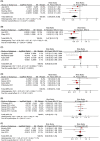Lifestyle interventions can reduce the risk of Barrett's esophagus: a systematic review and meta-analysis of 62 studies involving 250,157 participants
- PMID: 34128354
- PMCID: PMC8335822
- DOI: 10.1002/cam4.4061
Lifestyle interventions can reduce the risk of Barrett's esophagus: a systematic review and meta-analysis of 62 studies involving 250,157 participants
Abstract
Background: Barrett's esophagus (BE) is a well-established risk factor for esophageal adenocarcinoma. Our objective was to investigate the effectiveness of lifestyle interventions on BE risk.
Methods: We searched PubMed, Embase, and Web of Science up to 30 September 2020. The summary relative risks (RRs) and 95% confidence intervals (CIs) for the highest versus lowest categories of exposure were assessed. Analyses of subgroup, dose-response, sensitivity, and publication bias were conducted.
Results: Sixty-two studies were included that involved more than 250,157 participants and 22,608 cases. Seven lifestyle factors were investigated: smoking, alcohol, body mass index (BMI), physical activity, sleep time, medication, and diet. We observed statistically significant increased BE risks for smoking (RR = 1.35, 95% CI = 1.16-1.57), alcohol intake (RR = 1.23, 95% CI = 1.13-1.34), body fatness (RR = 1.08, 95% CI = 1.03-1.13), less sleep time (RR = 1.76, 95% CI = 1.24-2.49), and proton pump inhibitors use (RR = 1.64, 95% CI = 1.17-2.29). Reduced risks of BE were found for aspirin (RR = 0.70, 95% CI = 0.58-0.84) and the intake of vitamin C (RR = 0.59, 95% CI = 0.44-0.80), folate (RR = 0.47, 95% CI = 0.31-0.71), and fiber (RR = 0.95, 95% CI = 0.93-0.97). The quality of most included studies was high and the subgroup analysis according to the quality score showed significant results (p < 0.05). There was no publication bias for smoking and alcohol. Although the analysis suggested significant evidence of publication bias for BMI, sensitivity analysis showed that the changes in the recalculated RRs were not significant.
Conclusions: The large meta-analysis revealed that lifestyle modifications could reduce the risks of BE and, consequently, esophageal adenocarcinoma.
Keywords: Barrett's esophagus; esophageal adenocarcinoma; lifestyle; meta-analysis.
© 2021 The Authors. Cancer Medicine published by John Wiley & Sons Ltd.
Conflict of interest statement
The authors declare no potential conflict of interest.
Figures






Similar articles
-
Nonsteroidal anti-inflammatory drugs and esophageal inflammation - Barrett's esophagus - adenocarcinoma sequence: a meta-analysis.Dis Esophagus. 2011 Jul;24(5):318-24. doi: 10.1111/j.1442-2050.2010.01153.x. Epub 2010 Dec 17. Dis Esophagus. 2011. PMID: 21166737 Review.
-
Does physical activity protect against the development of gastroesophageal reflux disease, Barrett's esophagus, and esophageal adenocarcinoma? A review of the literature with a meta-analysis.Dis Esophagus. 2017 Nov 1;30(11):1-10. doi: 10.1093/dote/dox099. Dis Esophagus. 2017. PMID: 28881908 Review.
-
Determination of risk for Barrett's esophagus and esophageal adenocarcinoma.Curr Opin Gastroenterol. 2016 Jul;32(4):319-24. doi: 10.1097/MOG.0000000000000274. Curr Opin Gastroenterol. 2016. PMID: 27276368 Review.
-
Proton pump inhibitors may reduce the risk of high-grade dysplasia and/or esophageal adenocarcinoma in Barrett's esophagus: a systematic review and meta-analysis.Expert Rev Clin Pharmacol. 2022 Jan;15(1):79-88. doi: 10.1080/17512433.2022.2008909. Epub 2021 Nov 27. Expert Rev Clin Pharmacol. 2022. PMID: 34806503
-
Chemoprevention in Barrett's esophagus: A pill a day?Gastrointest Endosc Clin N Am. 2011 Jan;21(1):155-70. doi: 10.1016/j.giec.2010.09.005. Gastrointest Endosc Clin N Am. 2011. PMID: 21112505 Review.
Cited by
-
Diagnosis and Management of Barrett's Esophagus.J Clin Med. 2023 Mar 9;12(6):2141. doi: 10.3390/jcm12062141. J Clin Med. 2023. PMID: 36983142 Free PMC article. Review.
-
Sleep Behaviors, Genetic Predispositions, and Risk of Esophageal Cancer.Cancer Epidemiol Biomarkers Prev. 2023 Aug 1;32(8):1079-1086. doi: 10.1158/1055-9965.EPI-23-0101. Cancer Epidemiol Biomarkers Prev. 2023. PMID: 37195052 Free PMC article.
-
Analysis of Barrett's Esophagus and Its Risk Factors: A Cross-Sectional Study of 10,122 Subjects at a Japanese Health Examination Center.Digestion. 2022;103(6):411-420. doi: 10.1159/000526154. Epub 2022 Sep 8. Digestion. 2022. PMID: 36075194 Free PMC article.
-
Relationship Between Dietary Fiber and Vitamin C Intake and Oral Cancer.Front Public Health. 2022 May 12;10:880506. doi: 10.3389/fpubh.2022.880506. eCollection 2022. Front Public Health. 2022. PMID: 35646749 Free PMC article.
-
Dietary and Nutritional Support in Gastrointestinal Diseases of the Upper Gastrointestinal Tract (I): Esophagus.Nutrients. 2022 Nov 14;14(22):4819. doi: 10.3390/nu14224819. Nutrients. 2022. PMID: 36432505 Free PMC article. Review.
References
-
- Bray F, Ferlay J, Soerjomataram I, Siegel RL, Torre LA, Jemal A. Global cancer statistics 2018: GLOBOCAN estimates of incidence and mortality worldwide for 36 cancers in 185 countries. CA Cancer J Clin. 2018;68:394‐424. - PubMed
-
- Wani S, Rubenstein JH, Vieth M, Bergman J. Diagnosis and management of low‐grade dysplasia in barrett's esophagus: expert review from the clinical practice updates committee of the American Gastroenterological Association. Gastroenterology. 2016;151:822‐835. - PubMed
-
- Weston AP, Sharma P, Mathur S, et al. Risk stratification of Barrett's esophagus: updated prospective multivariate analysis. Am J Gastroenterol. 2004;99:1657‐1666. - PubMed
-
- Hvid‐Jensen F, Pedersen L, Drewes AM, Sorensen HT, Funch‐Jensen P. Incidence of adenocarcinoma among patients with Barrett's esophagus. N Engl J Med. 2011;365:1375‐1383. - PubMed
-
- Conio M, Filiberti R, Blanchi S, et al. Risk factors for Barrett's esophagus: a case‐control study. Int J Cancer. 2002;97:225‐229. - PubMed
Publication types
MeSH terms
Substances
Grants and funding
LinkOut - more resources
Full Text Sources
Medical

